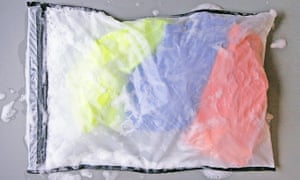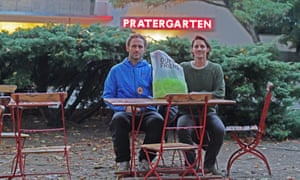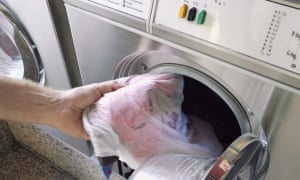https://www.theguardian.com/sustainable-business/2017/feb/12/seafood-microfiber-pollution-patagonia-guppy-friend?CMP=share_btn_link
Microfibers are polluting our food chain. This laundry bag can stop that
Two German inventors created a laundry bag to prevent shedding microfibers ending up in oceans. Now, Patagonia will start selling it to customers
For the past three years, Alexander Nolte and Oliver Spies, surfing buddies and co-owners of Langbrett, a German retailer with four stores that sells surf gear and outdoor apparel, have been haunted by news reports connecting many of the products they sell to an emerging but serious environmental threat: microfiber pollution. Synthetic textiles, such as fleece jackets, send tiny plastic fibers into wastewater after washing. These bits eventually make their way into rivers, lakes and our oceans, where they pose health threats to plants and animals. The two men knew they had to act.
“We said, ‘either we have to stop selling fleece [apparel] or we have to think of a solution’,” explains Nolte. “So we went out to our beer garden and said ‘what can we do?’”
The beer-filled brainstorming session eventually led to Guppy Friend, a mesh laundry bag, that goes into the washing machine. The bag captures shedding fibers as clothes are tossed and spun, preventing the fibers from escaping. It’s roomy enough for a couple of fleece jackets or other apparel made of synthetic fabric. In two weeks, Langbrett, in partnership with outdoor clothing company Patagonia, will start shipping the Guppy Friend to the backers of their Kickstarter campaign. Patagonia will then begin selling the bag to customers.
The Guppy Friend is the first device designed and marketed specifically to prevent microfiber pollution. Microfibers are tiny, so they can easily move through sewage treatment plants. Natural fibers, such as cotton or wool, biodegrade over time. But synthetic fibers are problematic because they do not biodegrade, and tend to bind with molecules of harmful chemical pollutants found in wastewater, such as pesticides or flame retardants. Plus, fibers from apparel are often coated with chemicals to achieve performance attributes such as water resistance. Studies have shown health problems among plankton and other small organisms that eat microfibers, which then make their way up the food chain. Researchers have found high numbers of fibers inside fish and shellfish sold at markets.
To date, no studies have shown that microfibers cause health problems in humans. But that’s cold comfort to Nolte: “Scientific research is slow, so it might take another generation to find out what harm [these pollutants] will do. I don’t want to wait that long.”
Nolte and Spies worked with German research institute Fraunhofer to test and vet the bag’s design and material. They settled on polyamide, also known as nylon, that doesn’t shed fibers easily. It’s made with a 50-micron mesh, a width that allows soapy water to enter the bag without allowing fibers to leave. When the bag is removed from the washer at the end of a cycle, the fiber – visible against the white mesh – can be removed by hand and disposed of. Tests show that the bag remains functional and intact after hundreds of washings.
The duo isn’t alone in tackling the problem in the laundry room. A startup called the Rozalia Project is developing a microfiber-catching device, but it is not yet available. Devices called after-market filters are already available – these are designed to reduce the amount of lint that enters septic systems. But unless you have some plumbing skills, hiring a plumber to install the $130 filters can be expensive.
Guppy Friend attracted the attention of Patagonia last summer when word about the project reached Phil Graves, managing director of Tin Shed Ventures, Patagonia’s investment fund. Patagonia already had a relationship with Langbrett, which sells Patagonia clothing.
Patagonia is interested in reducing microfiber pollution, based on the results of a study it commissioned at the University of California at Santa Barbara in 2015. Researchers calculated the microfibers shed from Patagonia outerwear during laundry, and found that a single fleece jacket sheds as many as 250,000 synthetic fibers. Using sales numbers, the researchers extrapolated that about 100,000 jackets are in use worldwide each year, and washing them would produce enough plastic to make 11,900 grocery bags.
“We received early prototypes [of the bag] and tested them with the UCSB researchers we had worked with on our fiber loss study. They confirmed that the bag trapped anywhere from 90-95% of fibers,” Graves says. “We brought in our material engineers and gave [Nolte and Spies] feedback on construction.” Nolte says design improvements have boosted the bag’s ability to capture fibers to 99%.
Patagonia gave Nolte and Spies financial support – a €100,000 ($108,000) grant – to develop the mesh bag and a supply chain for it. The duo also launched the Kickstarter campaign that ran from last October to December and raised €28,640 ($30,604) from 668 backers.
In exchange for the grant, Nolte and Spies agreed to let Patagonia be the first retailer, aside from Langbrett, to sell Guppy Friend.
Patagonia plans to sell Guppy Friend at the cost of buying and shipping it from Nolte and Spies – the California company won’t be making a profit. It hasn’t settled on a retail price yet, but it will likely be between $20-$30.
Since sales of synthetic fabric are growing, Guppy Friend will need to be a big seller to make a dent in microfiber pollution. So how likely is that?
It will require some convincing. Nik Sawe, a Stanford University researcher who uses neuroscience to study how consumers make decisions on environmental issues, says the key is to use emotion to influence behavior.
“If Guppy Friend can appeal to consumers’ feelings around the negative impacts of microfiber pollution, it might be able to elicit them to spend $20 or $30 for the bag,” he says.
In the meantime, Nolte says he’s gotten a lot of interest from retailers. So far, he and Nolte have 30,000 pre-orders for Guppy Friend, from Patagonia and other retailers he could not yet name.
Next up: Nolte and Spies are also working on reducing microfiber losses before the fabric reaches the laundry room. They are working with Deutsche Textilforschungszentrum, a German standards body, to create a metric that will show the rate/amount of fiber losses of a given textile. They hope clothing designers will choose fabrics that aren’t prone to shedding.
“We know that higher quality fabrics shed fewer fibers,” he says. He hopes the testing standard will make that clear to brands and consumers. But eventually it might take government regulation to curb the sale of high-shed synthetics, he says.
But with Guppy Friend, he says: “We can act now. We do not need to wait for anyone.”




沒有留言:
張貼留言